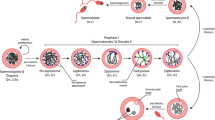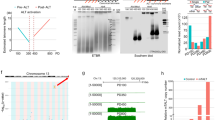Abstract
Telomeres serve to protect the ends of chromosomes, and failure to maintain telomeres can lead to dramatic genomic instability. Human TPP1 was identified as a protein which interacts with components of a telomere cap complex, but does not directly bind to telomeric DNA. While biochemical interactions indicate a function in telomere biology, much remains to be learned regarding the roles of TPP1 in vivo. We previously reported the positional cloning of the gene responsible for the adrenocortical dysplasia (acd) mouse phenotype, which revealed a mutation in the mouse homologue encoding TPP1. We find that cells from homozygous acd mice harbor chromosomes fused at telomere sequences, demonstrating a role in telomere protection in vivo. Surprisingly, our studies also reveal fusions and radial structures lacking internal telomere sequences, which are not anticipated from a simple deficiency in telomere protection. Employing spectral karyotyping and telomere FISH in a combined approach, we have uncovered a striking pattern; fusions with telomeric sequences involve nonhomologous chromosomes while those lacking telomeric sequences involve homologues. Together, these studies show that Tpp1/Acd plays a vital role in telomere protection, but likely has additional functions yet to be defined.
Similar content being viewed by others
References
Ahkter S, Richie CT, Zhang N, Behringer RR, Zhu C, Legerski RJ (2005) Snm1-deficient mice exhibit accelerated tumorigenesis and susceptibility to infection. Mol Cell Biol 25: 10071–0078.
Beamer WG, Sweet HO, Bronson RT, Shire JG, Orth DN, Davisson MT (1994) Adrenocortical dysplasia: a mouse model system for adrenocortical insufficiency. J Endocrinol 141: 33–3.
Blackburn EH, Greider CW, Szostak JW (2006) Telomeres and telomerase: the path from maize, Tetrahymena and yeast to human cancer and aging. Nat Med 12: 1133–138.
Blasco MA (2005) Telomeres and human disease: ageing, cancer and beyond. Nat Rev Genet 6: 611–22.
Celli GB, De Lange T (2005) DNA processing is not required for ATM-mediated telomere damage response after TRF2 deletion. Nat Cell Biol 7: 712–18.
Celli GB, Denchi EL, De Lange T (2006) Ku70 stimulates fusion of dysfunctional telomeres yet protects chromosome ends from homologous recombination. Nat Cell Biol 8: 885–90.
Chang S, Khoo C, Depinho RA (2001) Modeling chromosomal instability and epithelial carcinogenesis in the telomerase-deficient mouse. Semin Cancer Biol 11: 227–39.
Chang S, Multani AS, Cabrera NG et al. (2004) Essential role of limiting telomeres in the pathogenesis of Werner syndrome. Nat Genet 36: 877–82.
Chiang YJ, Kim SH, Tessarollo L, Campisi J, Hodes RJ (2004) Telomere-associated protein TIN2 is essential for early embryonic development through a telomerase-independent pathway. Mol Cell Biol 24: 6631–634.
De Lange T (2004) T-loops and the origin of telomeres. Nat Rev Mol Cell Biol 5: 323–29.
De Lange T (2005) Shelterin: the protein complex that shapes and safeguards human telomeres. Genes Dev 19: 2100–110.
Dmitriev PV, Petrov AV, Dontsova OA (2003) Yeast telosome complex: components and their functions. Biochemistry (Mosc) 68: 718–34.
Dronkert ML, De Wit J, Boeve M et al. (2000) Disruption of mouse SNM1 causes increased sensitivity to the DNA interstrand cross-linking agent mitomycin C. Mol Cell Biol 20: 4553–561.
Espejel S, Franco S, Sgura A et al. (2002) Functional interaction between DNA-PKcs and telomerase in telomere length maintenance. Embo J 21: 6275–287.
Hayflick L (1965) The limited in vitro lifetime of human diploid cell strains. Exp Cell Res 37: 614–36.
Hockemeyer D, Daniels JP, Takai H, De Lange T (2006) Recent expansion of the telomeric complex in rodents: two distinct POT1 proteins protect mouse telomeres. Cell 126: 63–7.
Hockemeyer D, Palm W, Else T et al. (2007) Telomere protection by mammalian Pot1 requires interaction with Tpp1. Nat Struct Mol Biol 14: 754–61.
Houghtaling Br, Cuttonaro L, Chang W, Smith S (2004) A dynamic molecular link between the telomere length regulator TRF1 and the chromosome end protector TRF2. Curr Biol 14: 1621–631.
Iwano T, Tachibana M, Reth M, Shinkai Y (2004) Importance of TRF1 for functional telomere structure. J Biol Chem 279: 1442–448.
Karlseder J, Kachatrian L, Takai H et al. (2003) Targeted deletion reveals an essential function for the telomere length regulator Trf1. Mol Cell Biol 23: 6533–541.
Keegan Ce, Hutz Je, Else T et al. (2005) Urogenital and caudal dysgenesis in adrenocortical dysplasia (acd) mice is caused by a splicing mutation in a novel telomeric regulator. Hum Mol Genet 14: 113–23.
Kipling D, Cooke HJ (1990) Hypervariable ultra-long telomeres in mice. Nature 347: 400–02.
Kuhn EM, Therman E (1982) Origin of symmetrical triradial chromosomes in human cells. Chromosoma 86: 673–81.
Kuhn EM, Therman E (1986) Cytogenetics of Bloom’s syndrome. Cancer Genet Cytogenet 22: 1–8.
Lansdorp PM, Verwoerd NP, Van De Rijke FM et al. (1996) Heterogeneity in telomere length of human chromosomes. Hum Mol Genet 5: 685–91.
Lebel M, Leder P (1998) A deletion within the murine Werner syndrome helicase induces sensitivity to inhibitors of topoisomerase and loss of cellular proliferative capacity. Proc Natl Acad Sci USA 95: 13097–3102.
Lee HW, Blasco MA, Gottlieb GJ, Horner JW 2nd, Greider CW, Depinho RA (1998) Essential role of mouse telomerase in highly proliferative organs. Nature 392: 569–74.
Liu D, O’Connor MS, Qin J, Songyang Z (2004a) Telosome, a mammalian telomere-associated complex formed by multiple telomeric proteins. J Biol Chem 279: 51338–1342.
Liu D, Safari A, O’Connor MS et al. (2004b) PTOP interacts with POT1 and regulates its localization to telomeres. Nat Cell Biol 6: 673–80.
Liyanage M, Coleman A, Du Manoir S et al. (1996) Multicolour spectral karyotyping of mouse chromosomes. Nat Genet 14: 312–15.
Marrone A, Walne A, Dokal I (2005) Dyskeratosis congenita: telomerase, telomeres and anticipation. Curr Opin Genet Dev 15: 249–57.
McClintock B (1941) The stability of broken ends of chromosomes in Zea mays. Genetics 26: 234–82.
Mills KD, Ferguson DO, Alt FW (2003) The role of DNA breaks in genomic instability and tumorigenesis. Immunol Rev 194: 77–5.
Murnane JP, Sabatier L (2004) Chromosome rearrangements resulting from telomere dysfunction and their role in cancer. Bioessays 26: 1164–174.
O’Connor MS, Safari A, Xin H, Liu D, Songyang Z (2006) A critical role for TPP1 and TIN2 interaction in high-order telomeric complex assembly. Proc Natl Acad Sci USA 103: 11874–1879.
Rooney S, Sekiguchi J, Zhu C et al. (2002) Leaky Scid phenotype associated with defective V(D)J coding end processing in Artemis-deficient mice. Mol Cell 10: 1379–390.
Schrock E, Zschieschang P, O’Brien P et al. (2006) Spectral karyotyping of human, mouse, rat and ape chromosomes—applications for genetic diagnostics and research. Cytogenet Genome Res 114: 199–21.
Smogorzewska A, Karlseder J, Holtgreve-Grez H, Jauch A, De Lange T (2002) DNA ligase IV-dependent NHEJ of deprotected mammalian telomeres in G1 and G2. Curr Biol 12: 1635–644.
Van Steensel B, Smogorzewska A, De Lange T (1998) TRF2 protects human telomeres from end-to-end fusions. Cell 92: 401–13.
Veldman T, Etheridge KT, Counter CM (2004) Loss of hPot1 function leads to telomere instability and a cut-like phenotype. Curr Biol 14: 2264–270.
Vulliamy T, Marrone A, Goldman F et al. (2001) The RNA component of telomerase is mutated in autosomal dominant dyskeratosis congenita. Nature 413: 432–35.
Wang F, Podell Er, Zaug Aj et al. (2007) The POT1-TPP1 telomere complex is a telomerase processivity factor. Nature 445: 506–10.
Wu L, Multani As, He H et al. (2006) Pot1 deficiency initiates DNA damage checkpoint activation and aberrant homologous recombination at telomeres. Cell 126: 49–2.
Xin H, Liu D, Wan M et al. (2007) TPP1 is a homologue of ciliate TEBP-beta and interacts with POT1 to recruit telomerase. Nature 445: 559–62.
Ye Jz, Hockemeyer D, Krutchinsky AN et al. (2004) POT1-interacting protein PIP1: a telomere length regulator that recruits POT1 to the TIN2/TRF1 complex. Genes Dev 18: 1649–654.
Author information
Authors and Affiliations
Corresponding author
Rights and permissions
About this article
Cite this article
Else, T., Theisen, B.K., Wu, Y. et al. Tpp1/Acd maintains genomic stability through a complex role in telomere protection. Chromosome Res 15, 1001–1013 (2007). https://doi.org/10.1007/s10577-007-1175-5
Received:
Revised:
Accepted:
Published:
Issue Date:
DOI: https://doi.org/10.1007/s10577-007-1175-5




